#like all the freemason symbolism
Text
Enneagram & Movement
If you look into the OG enneagram documents, they didn't even use it as a personality theory. Gurdijeff was never typed with an "ego fixation" until after his death.
The creators of enneagram used it to map processes in nature. Read the Wikipedia page about the original enneagram, pre-Naranjo and pre-Ichazo. The OG theorists never took the movement out of the enneagram like Naranjo did when he wrote his chapters about all the different types as if they are static caricatures rather than moving beings. the original theorists were OBSESSED with movement between the numbers. They were trying to map biology to the hexad types.
In modern enneagram, we are obsessed with pinning ourselves to a static point, which I think is moronic because an enneagram that doesn't move is a dead symbol. Never forget this quote.
In order to understand the enneagram it must be thought of as in motion, as moving. A motionless enneagram is a dead symbol, the living symbol is in motion.
- George Gurdijeff
Tritypes based on the head / heart / gut triad were not a thing until Oscar Ichazo made them so. Pre-Ichazo, enneagrammers were concerned with all sorts of "tritypes" beyond the 27 common ones we know. 147, 285, 369, 428, 571, etc. They were even concerned with quadtypes, quintypes and sextypes. There was far more flexibility in their thinking about how to use the enneagram map, as they did not confine themselves to these arbitrary rules that we use in modern enneagram, and they were not obsessed with their own ego fixations.
The Sufis used enneagram as a personality theory, but not in the same way we do in 2022. Again, they were not obsessed with their own egos. They did not go labelling themselves as this number and that number. They explained the points on the enneagram as vices / virtues that all humans have inside of them and all humans can relate to.
-----------
As for me, I type myself the way I do because that is the movement I observe inside of myself. I never saw my fixation as an ego fixation that I needed to "fix" or rid myself of. I saw it as an impartial pattern operating inside of me, for better or for worse. A pattern I enjoy observing, through observing my feelings and reactions and psychological state over time.
I am someone who started from observing the enneagram inside of myself as a moving symbol. Now I am expanding towards seeing it more broadly applicable to things beyond myself and the personalities of people I know. Going back to the basics where we applied it to biological patterns and nature patterns and patterns which weren't our egos. But perhaps starting from inside ourselves and our feelings and our reactions is the best way to develop a framework which lets us understand things more broadly.
#i am in the enneagram rabbit hole#because i can feel this system in my body#it is realer than any rabbit hole ive been down. most rabbit holes are just fakedeep.#arbitrary symbolism thrown together by some dude tryna be deep#tryna be god#like all the freemason symbolism#but with enneagram#i can feel the movement of the patterns#thats why the inventer (gurdijeff) is always typed as an 8-9 liner... lol... zero shock#george gurdijeff#enneagram#typology#sufi mysticism
3 notes
·
View notes
Text
ohohooo my god. this is insane. absolute and total mess all around. the girls are fightinggggg
#the last paragraph…#god. they are just so absurd. like jesus christ#well guys it seems ur mindset for years of ‘we dont trust anyone’ is taking a significant toll on the organizational structure#not that they have. any structure at all anyways. but still man thats a lot of division#its hard to choose a favourite part of this. theyre fighting against the ‘trans agenda AND the math agenda’?? yall not rocking with math??#the child with the freemason symbol?? thats insane. the claim that children are being kidnapped ‘by degenerates on horseback’ is really sooo#cdnpoli#sorry. don’t typically post this stuff as i like to keep it light on here but this is really something else. good lord
7 notes
·
View notes
Text
me, waking up drenched in sweat, violently sitting up in bed and letting out a gasp: IT'S A METAPHOR FOR BEING A YOUTUBER
idk if someone already thought of this and this is also probably the most obvious reading of it but here i go anyway: i was just walking a dog and listening to potato prints and when phil said "you've come a long way daniel" i was like "huh phil is in the teaching position in all of these just like he was for youtube" like phil just gives editing pro tips the whole time and it all parallels their story as a youtube duo.
and obviously the entertainment industry is rife (not proper usage of that word but it Feels Right so fuck you) with satanic symbolism/imagery/iconography/motifs. being an entertainer is "selling your soul to the devil" etc etc and we know dan hates being a youtuber and does feel that way. you gotta upload twice a day every day in order to be the number one art channel on youtube dot com after all. you gotta make those crafts for satan. bo burnham has a ton of lyrics/songs that i'm thinking about rn like "you used to do comedy when you felt like being funny but now you're contractually obligated so dance you fucking monkeeeey DANCE MONKEY DAAAANCE" and in "repeat stuff" which is a commentary of how mainstream pop love songs and pop stars have to be really superficial and unoriginal because they need to appeal to everyone and at one point he sucks satan off lmao and is like AHFRUEHQFWIIO I AM A VESSEL IDUSHISKA 666 KAJSDFI ILLUMINATI UIGDFSAHIO FREEMASONS. highly recommend looking at the lyrics to that song if you're into that kind of thing.
also the (very rightful) dig at phannies for the "don't cry craft" spamming like "we love all of our crafty audience that spread the message of this channel on all the other videos on the internet! everywhere! everybody enjoyed that!" is how creators who want to keep status have to address their audiences no matter how annoying or harmful they're being. thinking of the ajr line "stay out of politics, stay on the fence / stay out of all of it to keep half your fans" because like,, yeah if a creator ever expresses an opinion that declares their feelings on one side of an issue then they will lose support (smosh is a perfect example of a bunch of people never ever ever expressing an opinion if it could be considered controversial among their audience, like refusing to address the genocide happening right now and just taking their zionist member who the fans are mad at out of some videos to be like "shhhhh nothing to see here we don't know what you're talking about"), ESPECIALLY if that issue is the behaviour of their audience.
obviously the first dapc video was not made with any intended meaning, they just woke up and were like "let's be weird and freak people out" and they did that, and then adding in symbolism and making it all mean something developed with time. but i'm gonna pretend that it has always had consistent meaning because i'm neurodivergent and love overanalysing silly little media.
i am so jhfbvdahfkiufadkhlj right now so if anyone has more theories or things to add lmk and thank you for coming to my ted talk
#me saying shit#dnp#dan and phil#phan#dan howell#daniel howell#amazingphil#phil lester#danisnotonfire#yeet my deet#yeet my deenp#danandphilcrafts#squareflakes#glitterfaces#potato prints#slime
232 notes
·
View notes
Text
Aziraphale's Ring Is a Queer Symbol
In a previous post I hold forth about the symbolism of the lion rampant on the escutcheon of Aziraphale's signet ring. The upshot is that the golden lion is used by Heaven as a symbol of its threat and its merciless, murderous corporate culture, and I argue that in S3 Aziraphale must subvert this stamp of Heavenly ownership and symbolically redefine the golden lion by summoning the courage to be soft.

Now I've learned some new stuff about how signet rings are worn. Come, sistren, and get nerdy with me.
Aziraphale's ring is one of several we see angels wearing in Good Omens. Here in an indispensably useful post, @indigovigilance lists the known rings of Show Omens angels and those rings' qualities and placement. Note how of the angels who have rings, everyone except Saraqael and Aziraphale wear their rings on their LEFT pinky fingers. There's a reason for this.
Since the medieval period in Britain and Germany, and from there in the U.S., signet rings have been bestowed by professional associations as a sign of membership, particularly at the upper end of society: trade guilds, colleges, hospitals, the Church(es), noble families, and societies like the Freemasons all issue(d) signet rings to some of their members. The traditional placement for signet rings of show professional affiliation is the left pinky finger.
In fact, as it was not socially acceptable in or past the Victorian era for men to wear rings on more than one finger, men who wore signet rings and wedding rings both would have their wedding rings sized to fit the pinky finger below the signet. If a ring had to be moved to preserve masculinity, it wasn't the pinky ring that was going anywhere.
Family signets can be worn on any of a number of fingers, but since the Victorian period the men of the British Royal Family (who are from Germany) have been especial sticklers about wearing their signets on their left pinky fingers as well.
So. If you're British and you have a signet ring that's meant to indicate professional affiliation, you wear it on your left pinky.
But Aziraphale wears his signet ring on his RIGHT hand.
Before I offer my opinion on what that means, here's some more fun background on the history and significance of pinky rings in Anglo-American culture:
The Victorian period was when pinky rings started to become associated with queerness.
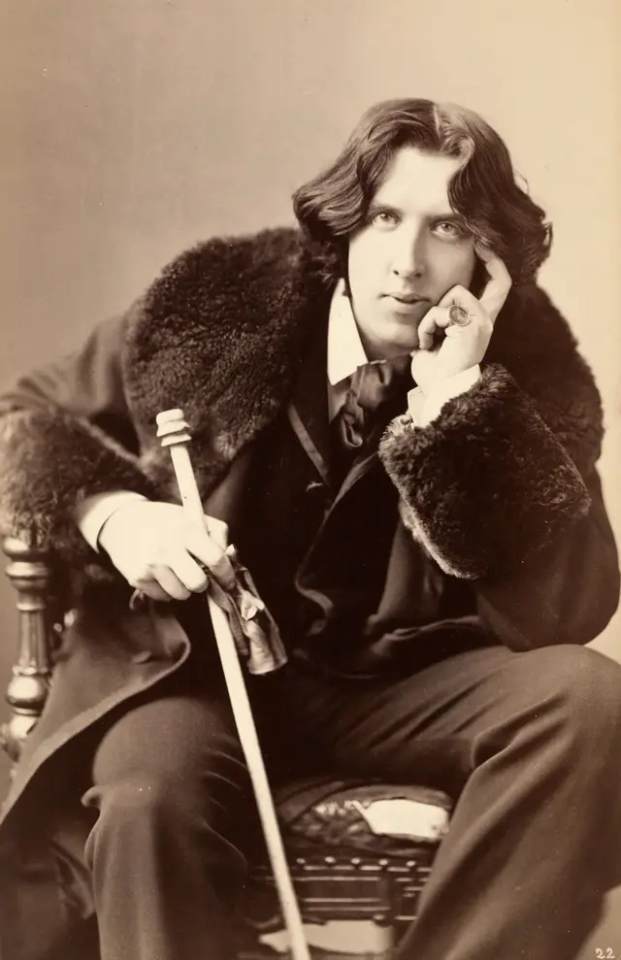
As fellow members of the Hundred Guineas Club, Oscar Wilde and Aziraphale would likely have been acquaintances.

According to Wikipedia (ibid.):
"During the Victorian era, both single men and women uninterested in pursuing marriage could wear a ring on the little finger of their left hand."
This quickly expanded to a pinky ring on either hand. Here's Wikipedia's picture of farmer and philanthropist Caroline Rose Foster in 1917, the Edwardian era, wearing a pinky ring on her right hand:
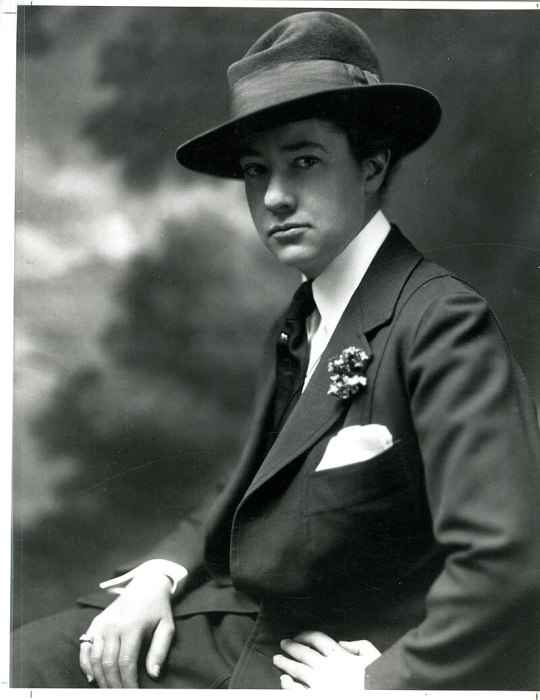
Do you smell a euphemism in "uninterested in pursuing marriage"? I do!
By midcentury--so only 30 years after Ms Foster up there--American and British queers, both men and women, were using signet pinky rings specifically to signal queerness to each other.
"For gay men in the 1950’s and 60’s, a way of signaling to others was through the wearing of a signet ring on the pinkie finger."
"During the 1950’s and 60’s signet rings were worn to signify membership of the gay community; both lesbians and homosexual men wore such rings."
The pinky rings @indigovigilance points out Maggie wears may mean she's an angel; they also match her midcentury lesbian style. Devious of the costumers to give her pinky rings on both hands rather than commit to one or the other.
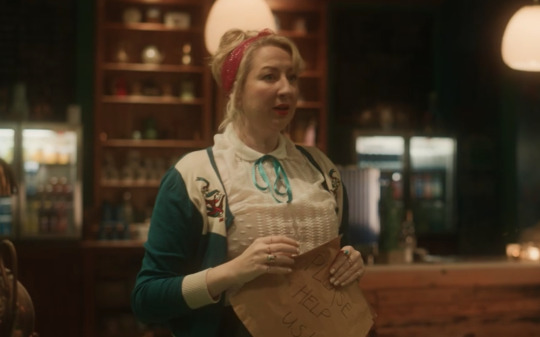
Screenshot by @indigovigilance
To review, there are three reasons a person in Anglo-American culture might wear a pinky ring:
They just feel like it--This can be any kind of ring and can be worn on either hand or both
Professional affiliation--This is a signet ring worn on the left pinky finger
To signal queerness--This is a signet ring and can be worn on either pinky finger
Aziraphale has worn a signet ring on his RIGHT pinky finger at least since he repaired the Eastern "Gate" in the Wall of Eden, so I'm not suggesting that he adopted the 20th-century pinky signet trend to signal his queerness (although as a clockably 'gay' 'man,' Soho fixture, and member of the Hundred Guineas Club, he may well have started it).
What I am suggesting is that Aziraphale has been given a ring by Heaven that Heaven intends him to use to show his professional affiliation, but as with the flaming sword he gives away, Aziraphale doesn't use the ring for its intended purpose. By wearing the ring on his right hand, Aziraphale removes the option of interpreting it as a symbol of his professional affiliation with Heaven and renders it strictly a personal ornament. He subverts a symbol of Heavenly menace into an object of beauty and queerness.
I mean queerness in both senses. If a human takes any symbolic notice of his ring, they'll note the signet is on his right hand and conclude Aziraphale is gay. If another angel takes any notice of it, they'll conclude Aziraphale is a bit odd--that he doesn't pay attention to the finer points of how to fit in with the archangels, doesn't do things like other angels do.
In conclusion, pinky signet rings as a queer signal are just the fucking coolest and I vote we bring them back immediately.
#good omens#good omens s2#good omens 2#aziraphale#aziraphale's ring#good omens lgbtq#pinky rings lgbtq#pinky rings as queer flagging#good omens angel rings#saraqael#michael#uriel#sandalphon
381 notes
·
View notes
Text

THE 7-RUNGED LADDER OF THE MYSTERIES
A symbol of progressive advancement from a lower to a higher sphere, which is common to Freemasonry and to many, if not all, of the Ancient Mysteries. In each, generally, as in Freemasonry, the number of steps was seven.
LADDER, BRAHMANICAL
The symbolic ladder used in the Mysteries of Brahma has seven steps, symbolic of the seven worlds of the Indian universe. The lowest is the Earth; the second, the World of Coexistence; the third, Heaven; the fourth, the Middle World, or intermediate region between the lower and the upper worlds; the fifth, the World of Births, in which souls are born again; the sixth, the Mansion of the Blessed; and the seventh, or topmost round, the Sphere of Truth, the abode of Brahma, who is himself a symbol of the sun.
LADDER, QABALISTIC
The ladder of the Qabalists consists of the ten Sephirot, or Emanations, of Deity. The steps are in an ascending series: Kingdom, Foundation, Splendor, Firmness, Beauty, Justice, Mercy, Intelligence, Wisdom, and the Crown. This ladder forms the exception to the usual number of seven steps or rounds;
LADDER, MITHRAITIC
In the Persian Mysteries of Mithras, there is a ladder of seven rounds, the passage through them being symbolical of the soul's approach to perfection. These rounds are called gates, and in allusion to them, the candidate is made to pass through seven dark and winding caverns, which process is called the ascent of the ladder of perfection. Each of these caverns is representative of a world, or a state of existence, through which the soul must pass in its progress from the first world to the last, the World of Truth. The seven steps are further symbolized by the seven planets and the seven metals. Thus, beginning at the bottom, we have Saturn represented by lead, Venus by copper, Jupiter by tin, Mercury by qiucksilver, Mars by iron, the Moon by silver, and the Sun by gold; the whole being a symbol of the sidereal progress of the sun through the universe.
LADDER OF IZADOSH
This ladder, belonging to the advanced Degrees of Freemasonry, consists of the seven following steps, beginning at the bottom: Justice, Equity, Kindliness, Good Faith, Labor, Patience, and Intelligence or Wisdom. Its supports are love of God and love of our neighbor, and their totality constitute a symbolism of the devoir or duty of Knighthood and Freemasonry, the fulfillment of which is necessary to make a Perfect Knight and Perfect Freemason.
LADDER, ROSICRUCIAN
Among the symbols of the Rosicrucians is a ladder of seven steps standing on a globe of the earth, with an open Bible, Square and Compass resting on top. Between each of the steps is one of the following letters, beginning from the bottom: I. N. R. I. F. S. C., being the initials of Iesus, Nazarenus, Rex, Iudaeorum, Fides, Spes, Caritas. These words suggesting Jesus of Nazareth, King of the Jews, Faith, Hope, Charity. But a more recondite or hidden meaning is sometimes given to the first four letters (INRI - All of Nature is Renewed by Fire).
LADDER, SCANDINAVIAN
Doctor Oliver refers the symbolic ladder used in the Gothic Mysteries to the Yggrasil, or sacred ashtree. It retains the idea of an ascent from a lower to a higher sphere, which was common to all the mystical ladder systems. At its root lies the dragon of death; at its top are the eagle and hawk, the symbols of life.
LADDER, THEOLOGICAL
The symbolic ladder of the Masonic Mysteries refers to the ladder seen by Jacob in his vision, and consists, like all symbolical ladders, of seven rounds, alluding to the four cardinal and the three theological virtues: Temperance, Fortitude, Prudence, Justice, Faith, Hope, and Charity
LADDER, JACOB'S
While sleeping one night on the bare earth and a stone for his pillow, Jacob beheld the vision of a ladder, whose foot rested on the earth and whose top reached to heaven. Angels were continually ascending and descending upon it, and promised him the blessing of a numerous and happy posterity. This ladder, so remarkable in the history of the Jewish people, finds its analogue in all the ancient initiations. It is certain that the ladder as a symbol of moral and intellectual progress existed almost universally in antiquity, presenting itself either as a succession of steps, of gates, of Degrees, or in some other modified form. The number of the steps varied; although the favorite one appears to have been seven, in reference, apparently, to the mystical character almost everywhere given to that number.
- An Encyclopedia of Freemasonary and its Kindred Sciences by Albert C. Mackey MD
66 notes
·
View notes
Text
Judgement Day
Aziraphale's Edinburgh Journey: Part 4
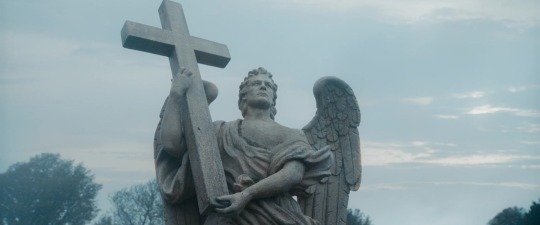
Aziraphale's trip to Edinburgh - and most of S2 - is filled with hints and references to the Second Coming. Once you are clued into this, they are everywhere, with some clues more obvious than others. Gabriel's statue is one of them, but it has another role as well (and it's not for hiding anything under, sorry.)
We also have a lot of references to the Freemasons in S2, particularly in Edinburgh, but you can see related symbolism elsewhere - they use some of the same symbolism used around Memento mori, and they also believe in working towards upholding values in life to be rewarded in the afterlife. Judgement Day looms large for all, not matter what their belief.
Judgment in the Tarot

Judgement is the penultimate card of the Major Arcana in the Tarot - the final card is The World, where the journey ends and everything comes together in harmony. But first, one must be summoned to their reckoning, and the past weighed up. It marks the completion of a karmic cycle; its time for renewal.
Three naked figures, a man, a woman and a child, rise out of the darkness of the underworld. Their nakedness denotes their spirituality, they have thrown off the clothes and material things of a physical life. An angel in the sky with a trumpet summons them to be reborn.
But which angel is it on the card? The book I'm favoring to do these card interpretations says its Michael. The information I have about cemetery angels (below) would indicate it to be Gabriel, who is sometimes depicted on headstones blowing a horn. Yet other lore says it's Raphael/Israfel that will blow the horn to start the Day of Judgement. And reading further, on some texts it just says it will be an archangel, they don't specify which one.
Cemetery Angels

The statue of Gabriel in the Edinburgh cemetery is an example of a cemetery angel. The type and pose of the angel is supposed to give some indication of the life that was lived. Small cherubs for children, a lily held for purity, a circular wreath for everlasting life, for example.
Gabriel's statue is doing several things at once: its wings are open, indicating its ready to take flight upwards for the resurrection, and its holding a cross. This is because this statue is a replica of one of the angels on the Ponte Sant'Angelo in Rome and they all hold something relating to the Passion. A cross is probably the most recognizable symbol of all, and instantly connected with Jesus. Everything here is pointing us to the Second Coming.
The Missing Cross
But the cross isn't there in every scene. It's been pointed out that its missing when Gabriel shows his statue to Beelzebub in the present.

This only appears to be the case when we view this scene from a distance. When we see the statue from between their shoulders, the cross is still there.
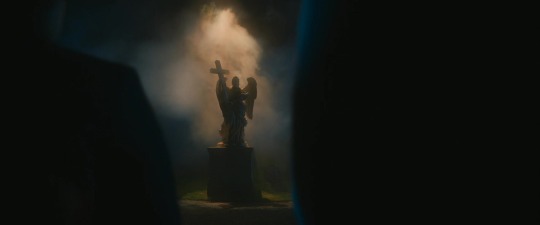
This is an inconsistent message, and casts some doubt on what its trying to tell us. Can Beelzebub see the cross or not? It can't be a demon thing, as Crowley has no problem seeing the cross in 1827. Is it instead a comment about Gabriel and Beelzebub as a pair?
There are a multitude of meanings that could be applied here around that missing cross: is it do with death and resurrection or is to do with having your sins forgiven and achieving eternal life? If its the latter, then the demons have always been excluded from that, right from the start.
Gazing in Parallel
Then there's this parallel in acts of admiration of the statue:

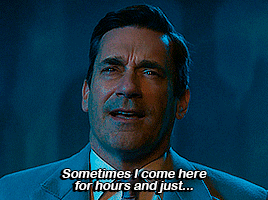
The very first time I watched S2 and I heard Crowley say "he probably comes here to stare at it," I knew yep, he sure does, and so he did.
Parallel pairs like this usually give us a nugget of information about the characters or story, and this one seems to be another thing pointing us to Gabriel being the peacock mentioned in the Job minisode (i.e. "Did you give wings to peacocks, Job...") An old slang definition of a peacock is "a person, especially a man, who is arrogant or likes dressing or behaving in a way that draws attention to themselves" and "a man who is very proud of his appearance and gives a lot of attention to his clothes and the way he dresses."
Let us not forget at this point that Crowley is linked to Gabriel in S2 as both a parallel and foil, and he, too, takes some pride in his appearance. But while Gabriel admires the creation that is himself, Crowley tends more to admire creations that he has had a hand in working on himself.
But there is a curious moment here that links us up with a scene from the beginning of S2, in Before the Beginning. Notice how Aziraphale looks back at Crowley as he he says Gabriel "Probably comes here to stare at it. Marveling at his own beauty."

Aziraphale has the same jealous look on his face as angel!Crowley marvels at the beauty of his newly created nebula and stars.

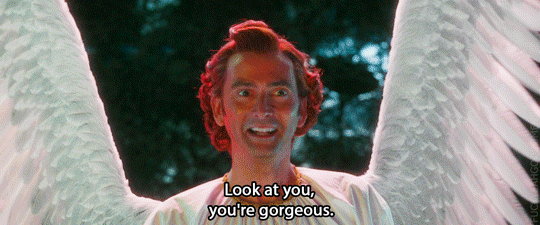
We have to remember that Before The Beginning was one of the last parts of S2 to be written, even though its at the start, but it includes a repeated parallel to the dates at the statue - angel!Crowley admires his creation, and Aziraphale looks a little jealous that he's not getting that same attention from Crowley.
Demons in the Mist
There is another, larger, parallel sequence that the statue plays a part in as well, and this connects us to S1, and I suspect to S3 as well. This is one of the mobius strip parallels that I sometimes talk about, where the story history repeats itself ad infinitum. Notice the misty nature of the present day scene below; this is an indication we are seeing more than two times and places at once.
It starts here, as we switch suddenly from 1827 back to present, just after Crowley is sucked down into Hell, leaving Aziraphale gazing up at the statue.
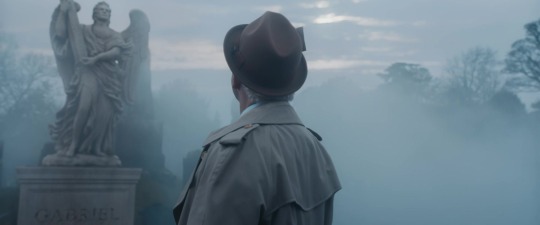
The parallel scene to this is the sushi restaurant in S1E1.

In that scene Crowley has been summoned to the cemetery to receive the antichrist and start Armageddon. He was supposed to be on a date with Aziraphale at the sushi restaurant, but Gabriel turns up instead, on the other side of Aziraphale - the same side the statue is on in S2.
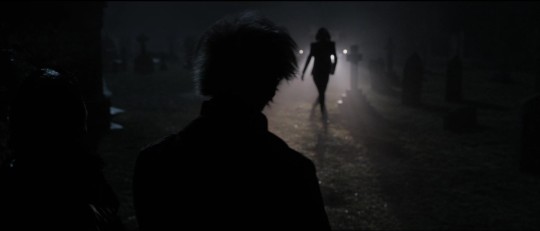
Next, there are two demons. The first time, Crowley was summoned to meet with Hastur and Ligur to start Armageddon. Only this time, in S2, its Aziraphale talking to the demons, not Crowley.
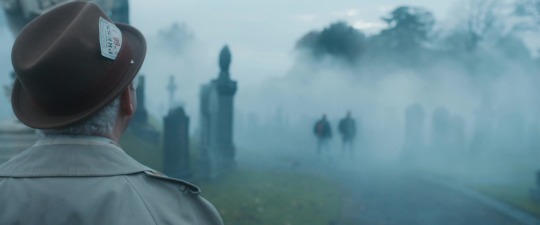
We have an indication that the Scottish pair are demon-related with the taller one having a misspelled tattoo on his forehead (and aren't there many stories of badly spelled tattoos?)
I think they also roughly match the height and size of Hastur and Ligur, too. And it's the Ligur-parallel that offers his phone - just like its Ligur that chats to Michael on the back channels that don't exist in S1.

Free phone call? Not a problem. It's been pointed out that when Crowley hangs up the phone handset in S1 after calling Aziraphale you can hear a coin falling into the coin return box - apparently there was a thing done in the old days of leaving some change in the coin return for people who didn't have any money and needed to make a call; a kindness for strangers, if you will. So it's not a worry that there is no credit on the phone when Aziraphale needs to make the call.
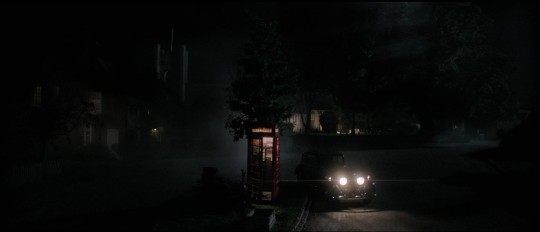
Lastly, we have some S3 foreshadowing, because this an Aziraphale scene and he connects us with the future. The old phone is looking worn and tatty, with the Union Jack on it, a sign of the Empire that is slowly fading, and is well past its peak. After he hands it back with a blessing, it looks renewed, with the St Andrews Cross of Scotland on it. I might live on the other side of the world from the UK but even I'm aware of the political debate around Scottish independence that has been ongoing for, well, many years now.
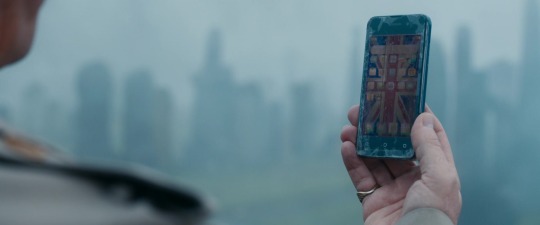

I can't help thinking we are going to see a parallel to this scene in S3 as well, with Aziraphale demanding some form communication from Hell or some demons for which he does "ask nicely" about. This is all working towards a change in the way the authoritative structure works for the angels and demons (the death and rebirth theme.)
Masonic Symbols
We are alerted to the presence of the Masons when Aziraphale does his detective cosplay and speaks to the barman in the Resurrectionist pub. If you are quick, you can also notice the square and compass symbol on the windows next to the pub as Aziraphale approaches, although most of us are looking at Jesus on the sign (and a reminder that we are looking out of a deliberate copy of the Eastern Gate of Eden here on the sign, too, into the deserted distance.)
The square and compass are a reminder of balance - the square at the bottom is about honesty and integrity, and the compass at the top represents wisdom and keeping one's desires within reach.

But why are we looking at Masons? I think this is because they represent a similar but different alternative to the Abrahamic religions the Good Omens AU is built around - they believe in a Supreme Being (God) and they believe in upholding certain virtues and doing good deeds in life so that they will be rewarded in the afterlife, and that there is an eternal afterlife; they just don't believe in going about it in the same way the church does.* The Catholic church doesn't allow one to be a Mason and a member of the church at the same time because of this clash in ideologies.
The other thing to note about Masons, is that Masons wear black tie evening dress to their Lodge meetings, like the corpse in the next image below. The barman in the present even says to Aziraphale "It's the first time I've seen one in a fancy grey suit, though." This is a big Clue - but you all missed it, because you latched on to the fancy grey suit part of the sentence that screamed "GABRIEL WAS HERE!!" at you and didn't hear the silent part that the barman was saying - that the other person that was with Gabriel was wearing a black suit.
Hello? Anyone paying attention here? No? Just me shouting into the void...right, well, carry on then.
We see three dead bodies in the Resurrectionists minisode, much like the three bodies on the Tarot card for Judgement. The first is this Mason, clearly identified by the apron he is wearing (the other two bodies are a priest and wee Morag.) The decoration on it would indicate what rank or degree of mastery he held within his lodge. The background was always white, for purity.
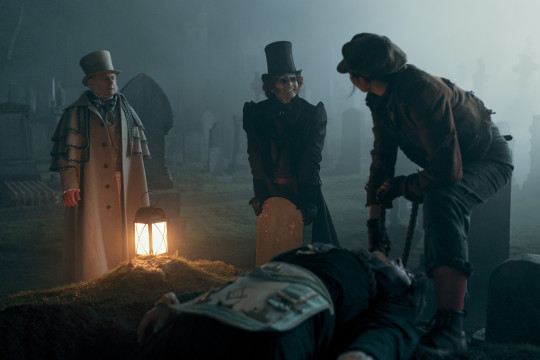
Coffins were a reminder that one day every one would die and return to dust. They were also a sign of leaving their previous life behind from before they joined the Masons and taking on their Masonic duties.
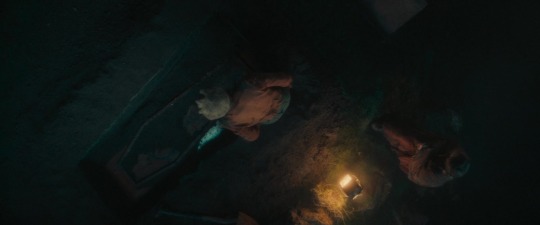
Skulls and cross bones were part of Memento mori - reminders that life was short. They also appeared on Mason tracer boards.

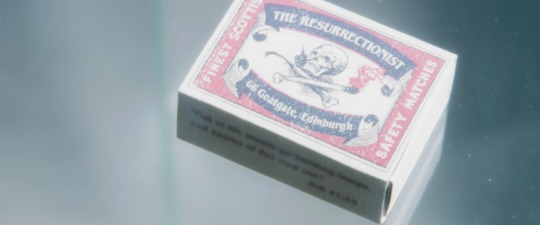
The hourglass was a particularly special symbol. While it, too, was a reminder that life was finite, it was also a reminder that life and death was a cycle. By turning the hourglass over, one started the cycle again. This also demonstrated the need at times for one to turn one's thoughts and actions around on their journey through life.
It was also a reminder that time was the great equalizer - it didn't matter your station in life, time always moved forward, and death would come for us all.
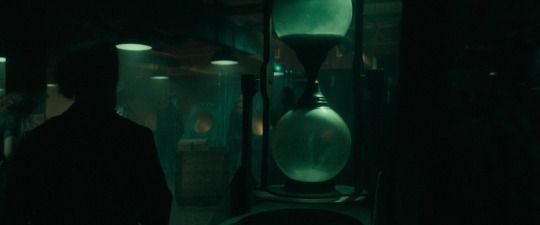
Onward to Part 5, dear readers! Time to see if we really know where we're going with all this!
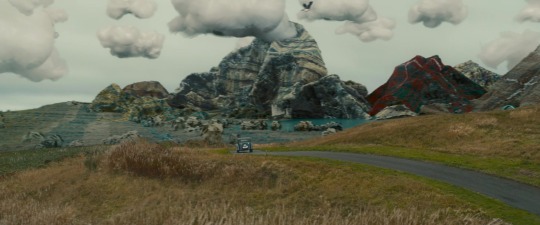
Thanks once again to @vidavalor for pointing out the parallel between the statue of Gabriel and the sushi restaurant in S1, where Crowley is pulled away by Hell both times and Gabriel appears on Aziraphale's right.
@kimberleyjean has also put together a collection of all the infinity loops and mobius strip references in GO here.
*I'm not sure what it was like in other countries, but I know in Australia during the mid 20th century to get anywhere in certain jobs and industries you either had to be a Catholic or a Mason. Without the backing of one of those organizations you wouldn't get far. My grandfather was a Mason, but not religious, and consequently rose quite high in the government dept he worked for - took me a long time to put all those pieces together, because it was never talked about in my family. I just knew he went to Lodge. It was only listening to some podcasts about history that I was able to work it out.
The other posts in this series can be found here:
Part 1: Detective Aziraphale
Part 2: Aziraphale-Beelzebub Parallels
Part 3: Stocktaking in the Basement
Part 5: I Know Where I'm Going
#good omens#good omens 2#good omens meta#aziraphale#judgement day#the second coming#cemetery angel#archangel gabriel#the sushi restaurant scene#free phone calls#masonic symbols#memento mori#every day#its getting closer#its all just a little bit of history repeating
75 notes
·
View notes
Text
Magnum Opus or Great Work: Alchemical Codes in "Harry Potter"
"I've never wanted to be a witch, but an alchemist, now that's a different matter. To invent this wizard world, I've learned a ridiculous amount about alchemy." JKR. By the way, it seems JKR never became an alchemist because you can't be that evil an alchemist, Joanne. Something went wrong.
The first part about Lily and James
Voldemort – an occult alchemist, Lucifer. Snape – a Seeker who chose the wrong Path. Dumbledore – Keeper of the Tower. Hermione – Hermes Trismegistus. Harry, Hermione and Ron – the three principles for creating the Philosopher's Stone.
Alchemy is the universal path of spiritual transformation. In a literal sense, universal, this code is practically everywhere–from ancient myths and the Bible to the philosophy of Nietzsche (though in his understanding) and Jung's books. Harry Potter himself is a complete alchemist's path, but there's also a well-displayed second path–the path of the occult alchemist.
True alchemy tells us that God is in everything, like a seed present in every person. Through alchemical transformation, a person can be reborn – and become golden, divine, immortal.
Many famous people were fascinated by these ideas – from Newton to Goethe, from Walter to Mozart. Yes, Walter and Mozart were freemasons, but freemasonry is built on the Magnum Opus, it's its foundation. Who has seen the opera The Magic Flute? A completely masonic opera: the surface layer was for the people, and the deeper layer – for the spiritual elite of that time. In this opera, the power of love transforms people and makes them divine. Oh, it seems to resemble Harry Potter, hehe... Harry Potter also has two layers – one as a fairytale about a wizard for teenagers, the other – for those who can "feel" the symbols, even without knowing them.
Each symbol can be interpreted in several ways, that's the complexity of alchemical symbolism. For example, Albus Dumbledore. He symbolizes (in JKR's own words) Spirit ( he's white), and Rubeus Hagrid – Soul (red) – and they're both like two fatherly figures for Harry, distant and warm, judicious and understanding. But all this is at the character level. Dumbledore has other meanings – much more important ones. As I've said before, the symbolic level and the character level are different levels. In interpreting symbols, you don't need to interpret every line, you need to take the context as a whole. Characters operate on one level, symbols – on another.
So, alchemy is an extension of the universal idea – to be reborn, you need to "die." Like Jesus died on the cross, Orpheus on the banks of the River Gebre, and Osiris in the coffin prepared by Typhon, in alchemy, until all the elements (parts of the old personality) die, the work cannot be completed.
The stages of this alchemical process can be traced in the lives of almost all world "heroes" and in the mythology and legends of many cultures. This is a universal code.
“Very truly I tell you, no one can see the kingdom of God unless they are born again” John 3:3
Alchemy proclaims that without decomposition, the Great Work cannot be accomplished.
The past Self dies on the cross and in the retorts and becomes black during decomposition. The new Self rises from hell, like a phoenix. The phoenix is a pure alchemical symbol.

This is the creation of the Philosopher's Stone.
It is symbolically described in "The Chymical Wedding of Christian Rosenkreutz". The book presents an allegorical story divided into "Seven Days" or "Seven Journeys," which tells how its author, Christian Rosenkreutz, was invited to a castle full of wonders to help with the "Chymical Wedding" of the king and queen. Harry also receives a letter in a storm (like Rosenkreutz) and goes to the castle for 7 years, chooses one of the four paths (Gryffindor), and so on.
Alchemists called the creation of the Philosopher's Stone the Great Work – Opus Magnum. This process consisted of three stages: decomposition (nigredo), rebirth (albedo), and final perfection (rubedo). Each of these stages corresponded to a specific colour: black, white and red.

Nigredo. Albedo. Rubedo.
In Harry Potter, these stages correspond to Sirius Black, Albus (white) Dumbledore, and Rubeus (red) Hagrid. The end of each stage is marked by their death. In the seventh book, it's Hagrid who carries the "dead" Harry.
There is a fundamental difference between "true alchemists" and "occult alchemist."
Tom Riddle is an occult alchemist. For him, the Great Work is also self-creation, but what kind? For him, it is complete mastery of his abilities and his future, and especially the complete liberation of his will.
Tom is a will, but his will not submissive to the will of God. It's a Luciferian will. The will of a fallen angel who began to oppose his own free will to the influence of Divine Love-Light. Instead, he sought and loved his own power outside Divinity, in himself.
"Better to reign in Hell, than serve in Heaven" John Milton, "Paradise Lost"
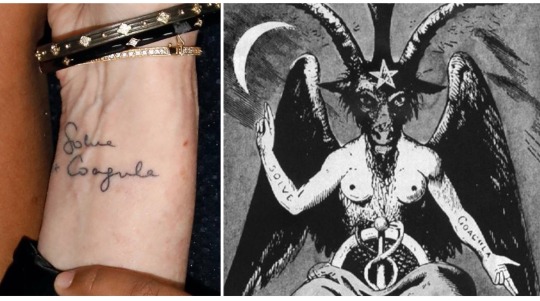
Baphomet, or the Sabbatic Goat, drawing by Eliphas Levi, on its hands are inscriptions "Solve et Coagula." This is an alchemical principle. JKR, by the way, also has such a tattoo.
In occultism, it is believed that magic is control of one's will, and a will can control matter. After all, what did his followers choose for their motto? Magic is Might. Harry never defeated Voldemort with such magic. Because he doesn't need it.
What does Tom boast about? Tom boasts that he has mastered the deepest depths of dark magic. He went so far in it as no one before. Dark magic requires an iron will, and Tom achieved incredible heights in it. He even achieved immortality in this material universe, literally cursing his soul! Only Tom doesn't understand that Dumbledore (a true alchemist) is not interested in all this. Because true immortality is not there. True transformation is not there. Because their paths are completely different – Dumbledore is going to the "God and divine immortality," and Tom is going to "material immortality."
In general, fans of occult alchemy, the Left-Hand Path, and Nietzschean philosophy probably consider Tom a much more interesting character because here he is – the king of matter, a man of incredible will and strength who destroys the slave Christian morality and proclaims that God is dead, long live the Übermensch (homo superior)! (Nietzsche would have been proud of him…) By the way, Bellatrix is most likely symbolically – Lilith, Adam's first wife according to Kabbalistic apocrypha, who rebelled against Adam. God created them equal, and Adam wanted to have power over Lilith... In short, Lilith is the first feminist in human history, hehe.
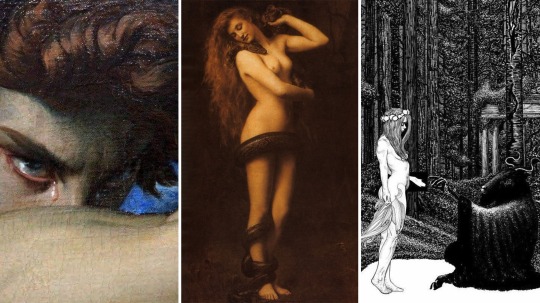
The Fallen Angel by Alexandre Cabanel. Lilith.
In short, Tom Riddle is such an adept of broken alchemy. Where Tom is his own personal will, Harry is Faith and the will of the Spirit. Harry is also very strong-willed, but his will is different, it's not individualistic. It's a will of sacrifice, a will of love, a will of mercy, a will of trust. The main theme of the seventh book is a crisis of faith. And what kind of will does one need to show to continue the quest for Horcruxes and not go for the Deathly Hallows? Simply put, the will of Harry and Tom is completely different.
And Tom will never understand this. He's an individualist. He's a Nietzschean Übermensch. He's reached the limits of human capabilities. But for what? From dust you are and to dust you shall return, Tom...
Severus Snape — a Seaker who chose the wrong Path
And Snape, by the way, initially turns away from Lily (Lily is love of God, represented in the world). Because he's obsessed with becoming dark magic, his ego and desire for secret knowledge and being proud are very great.
Btw, Lily is a mudblood. In the sense that God is not in shining beautiful armor. This is Lucifer's mask – to be pure, to shine, to sparkle. But the real God can be found by seeking, under the feet of the poorest and "dirtiest" person. After all, for God, everyone is equal. It's the Devil who divides.
And pure-bloods, for example, the Blacks, are "false purity." Luciferian purity. Material purity, purity of shining gold. It's division. And where there's division – there's the Devil.
In short, Snape turns away from Lily because this path is difficult, he doesn't understand how to approach her, he already uses dark magic, has a lot of knowledge, and delves into various secrets, and shows what "bad" paths other seekers (the Marauders) take... (The seeker is not my term, it's from the Rosicrucian manifesto, alchemists call themselves seekers) But Lily still refuses to unite Spirit and Soul. And he calls her a "mudblood," insulting her. For Lily, this is a sign that this soul is almost lost. And there's no sincere regret in him when he asks for forgiveness. He asks her to forgive him, but his soul is still on the old Path. Lily isn't angry with him, it's not about anger or offense. Snape's soul is almost lost at this moment, closed to the divine spark and love. After all, for love to enter your heart, you first need to open yourself to it.
Only when Snape sees true face of Tom's "alchemy," in which Tom is ready to kill Love, the divine spark, essentially kill God in the souls of all people, then Snape, as a real Seeker, realizes that he's going the wrong way... And he runs to the main Alchemist, Dumbledore, to ask to preserve this love, this manifestation of God on earth.
But you can't preserve it without preserving the seeker of the right Path in your soul (James) and without preserving the possibility of the emergence of the transformed soul (Harry).
This is a very important moment, not only because you can't kill people in principle. Dumbledore literally tells him that you can't save love of God, the divine spark in your soul, if you kill in yourself the one who reaches out to God (the deer) and if you kill the POSSIBILITY of becoming this new transformed soul (Harry).
For Snape, this becomes a turning point, and he decides to switch sides to true alchemy. Dumbledore asks in return for Snape's soul, but not in the sense that the Devil demands it, he asks for loyalty to the Path. Below I'll explain the symbolism of Dumbledore and what he means in terms of alchemical symbolism (I don’t think he is God).
Snape becomes loyal to Dumbledore. But Lily is killed, as is James. The world, despite the fact that Voldemort temporarily goes into hibernation (and the Savior is alive), plunges into despair. Sirius (as a divine symbol of light) is in captivity, Remus (a symbol of a seeker with a "good but not brave" soul) is somewhere wandering the world, and Harry lives very poorly with the Dursleys... Harry doesn't know any God, and the seeker in him is also "dead". And Voldemort will soon rise again, he's just gathering strength.
Harry's path is the path of returning to God through Mother of God (Theotokos). Because it is Mother of God who is the true Spirit. That's why he meets Lily only at the end of the seventh book, when he's almost completed the alchemical transformation. For Christians, this is heresy, but for alchemists, it's not. The Son and Mother of God are one whole. The Virgin Mary is part of the Trinity, because only through the spiritual unity of the Mother and the Son is the salvation of humanity possible.
And who does he meet her through? Through Snape. Who dedicated his entire life to transforming his Soul, merging it with the Spirit, ultimately coming to God.
He spent his whole life hating James, as a Seeker of a different kind, not like him—Snape always leaned a bit towards Nietzschean stories. And James always hated Dark Magic and all dark things (although this doesn't make the souls of this type much better, they can also be egocentric). Snape teaches Potions, he knows how to bottle up Love, Death and Luck... So much power, so much pride in this...
Recently, I reposted a very interesting post. Snape wanted to recover his soul, because he was guilty of Lily's death. A very beautiful meta, but I see a bit different alchemical meaning. His soul is broken not only because Lily partly died because of him. His soul is broken overall because of the Path he chose - that of an occult alchemist, and he remains a "spy" to the end of his days, playing two roles, constantly "here and there". He dies at the hands of his former master.
Snape takes Lily's letter because he needs Lily's love (like people wear crosses), while there isn't enough understanding of where to go (Dumbledore is already dead)
Snape always yearned for Lily. And Dumbledore asks for us, the readers: "After all this time?" And Snape answers for us "Always." You must love God always. And that is salvation for the soul.
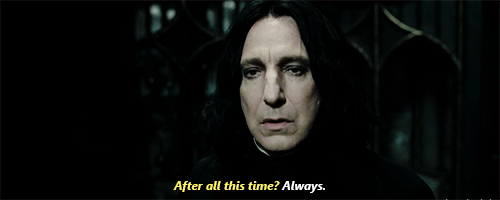
In general, Snape only understands towards the end that you cannot love Lily without Harry and even James. Only one Path leads to Lily - the same as James’s path. The path of Ego, pride, thirst for power, secret knowledge, occultism, malice, hatred must finally dissolve. Snape fully exposes himself to Harry, although he shouldn't have (he should only pass on information about death), revealing the good (and the bad) that he always hid. His revelation to him speaks of his complete acceptance. He shows him his soul, literally bowing his head to him - here I am, here is my soul, in some things I have no excuse, sometimes I have justification, but I've been seeking God, seeking love all my life.
Will you accept my wounded soul?
This is confession. The realest confession.
And Harry accepts. Of course, Harry accepts. He looks at him with Lily's eyes.
Because no matter how "bad" you are, if you truly love God in your soul, if you truly seek Him, there will always be a place for you in the City of God. Snape is the constantly replayed plot of the Prodigal Son's return.
At this moment, all the "black" in Snape dies – the nigredo. Tears - the white stage, purification – the albedo stage, purification. Blood – naturally, the red stage. The alchemical transformation for Snape is complete.
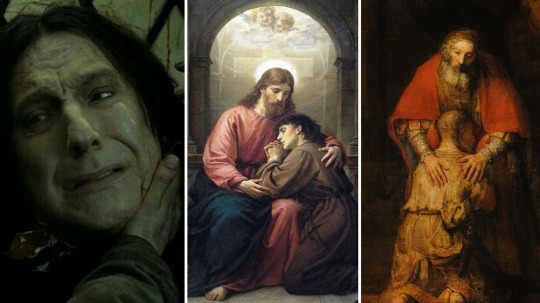
(But geniuses from TikTok will still say that Harry shouldn't have named his son Albus Severus, because Snape was baaaad. Ofc he was bad sometimes, that's the point!)
Dumbledore is the embodied Path and Plan
As I mentioned before, Dumbledore asks for Snape's soul in return, but not in the sense that the Devil demands it, he asks for loyalty to the alchemical Path.
Dumbledore, as an alchemist, besides embodying the completion of the albedo stage for Harry with his death, is also the embodied Path. Dumbledore is the highest Guardian of the Tower, who watches over the Paths of others, he is the Man of Spirit, he is the Principle, he is the Master. What is the difference between Dumbledore and Lily? Lily is a more important symbol, she is like pure divine power, God = love, as in what all souls dissolve. Dumbledore, on the other hand, is the Guardian of the Path through which everyone must pass. In short, Lily is the answer to the question "where", and Dumbledore is the "how". And Dumbledore is just a man who also underwent his alchemical transformation and who can also succumb to temptation. But Dumbledore is not GOD, imo. To personify God in a book is too much (even for me, although I’m not religious at all). I don’t like the idea of him being God and... really, where? God is transcendent and pure divine love emanates from Lily that’s why she almost an empty canvas. Dumbledore is a principle. He is the answer to the question "HOW". That's why he asks to believe in him, believe in the ALCHEMICAL PATH AND PLAN. FOLLOW THIS PLAN TO THE END. Ascend the tower, as I once ascended it. After all, he lives up there in the tower. He observes.
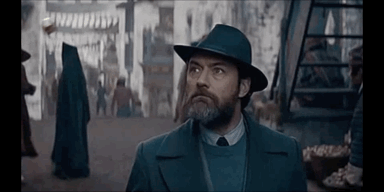
For Snape, Dumbledore is so important because Dumbledore is the Path, a new Path that he did not have. And Dumbledore's death is so important for everyone because now no one points them towards the Path. But they must find this Path within themselves. Because the answers are inside them. You cannot become a true Alchemist if you constantly rely on external help. It's time to see the Path independently.
"You must kill me."
There was a long silence, broken only by an odd clicking noise. Fawkes the phoenix was gnawing a bit of cuttlebone. (HP and DH)
After Dumbledore says that Snape must kill him, there is silence and a very clear symbol - the phoenix and the bone. It's time for their souls to go independently, to eat away all the old to come to rebirth. Meanwhile, they also need to save Draco, who, by "Lucifer's" order, is about to kill the Path (although you can't outplay God's plan...). And then Dumbledore reveals that Harry must die.
This shocks Snape. Like any alchemist on the Path. How so, to die? After all, we all do everything to become closer to God, to immortality, and you say – just die? What kind of Path is this?
"I thought…all these years…that we were protecting him for her. For Lily.”
After all, we were protecting Harry for Lily, because as I've already said, only through the spiritual unity of the Mother and the Son is the salvation of humanity possible. Snape is protecting the son for the mother, and Dumbledore wants to kill him? For what?
Simply put, Snape doesn't understand that no one can save Harry until he dies and is reborn. It's painful, but all heroes go through this path for rebirth.
Dumbledore knows that there is a "seed" of "evil" in Harry, as in any of us. After the fall, we all carry Luciferian part within us. This is the last thing that must die in Harry, and he himself must die for it.
No one promised that the path of the alchemist would be easy. It's understandable why not everyone loves Dumbledore, he seems too cold and manipulative, but there is no other way for Harry on the symbolic level.
The Great Work
There are three stages of the Great Work: decomposition (nigredo), purification (albedo) and ultimate perfection (rubedo). These stages for Harry culminate in the deaths of Sirius Black, Albus Dumbledore, and his own death, where he is carried out of the forest by Rubeus Hagrid.

And the result of his alchemical work should be Rebis — essentially the alchemical philosopher's stone, an androgynous being. In the collection of dialogues attributed to Hermes Trismegistus, God is depicted as androgynous. (Hermes Trismegistus is essentially the one who created the corpus of Hermetic texts).
Rebis is the unity of opposites. Day and night, Man and Woman, Good and Evil, Light and Darkness. All is one. There is no division. The wholeness of God. After the fall, we are all divided. And after the alchemical transformation, we can finally become whole and find ourselves and God.
In the form of merged men and women, sometimes depicted as the Virgin Mary and Christ, because They are one whole. As I have already said, for many alchemists, the Virgin Mary is part of the Trinity because only through the spiritual unity of the Mother and the Son was the redemption of original sin made possible. As I have already said, although Harry suffers more for James (his father turned out not to be as ideal as he thought), Lily is the main symbol in "Harry Potter".

The Nigredo stage literally means "blackness" - it signifies complete breakdown, decay, descent into the underworld, the trance of grief. It's a descent into the deepest fears, disbelief, denial, loss of self, anger, aggression. And through this - a return to the prima materia. This is what happens to Harry, "The Order of the Phoenix" is a very dark and depressing book, and with Sirius's death, this stage for Harry is completed. Sirius himself also undergoes transformations, but about this in the next part. The nigredo stage, during which a person's ego dissolves, is agonizing but necessary for further development. After the "I" meets its "shadow" and disintegrates into parts, it will need to be purified and recreated.
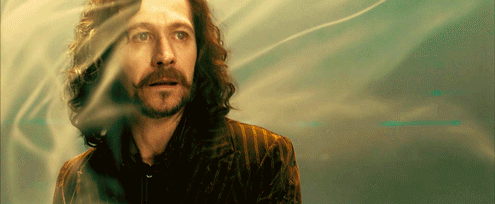
Albedo ("whiteness") symbolizes purification, transition to another world, change of life priorities, awakening, enlightenment. In alchemy, the transition from nigredo to albedo is achieved through the process of washing. The whole sixth book is misty, "white", "wet". "Washing" (albutio, baptisma) directly leads to whiteness (albedo). Purification. It's also silver, a lunar state. In Harry Potter, there is a character named Luna, which means moon in Latin. In different parts of the books, Luna also symbolizes this stage. With Dumbledore's death this stage for Harry completed.
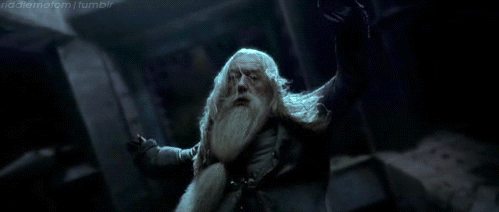
Rubedo ("redness") - the final stage of the alchemical Great Work. The alchemist must establish a kind of sacrificial relationship with his inner essence. At the final stage, the so-called "alchemical marriage" takes place: the marriage of the Red King and the White Queen - Soul and Spirit. Harry (soul) and Lily (spirit) are united. With Hagrid carrying Harry this stage for Harry completed.

Bu the way, the Golden Snitch is an alchemical symbol also.
Firstly, Harry's position is called the Seeker. Alchemists also called themselves that. Secondly, the winged disc is a very ancient symbol, meaning the sun (God) and immortality.
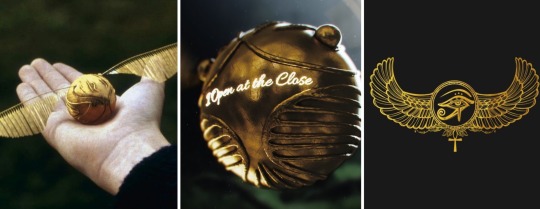
The Snitch reveals to him the Resurrection Stone, and Harry "encounters" his main symbols, but the main one is Lily. It is her he asks not to leave him.
Harry's death here is read by everyone as the well-known plot of Christ's crucifixion. The path to this death is also a reference to the agony of Jesus in the Garden of Gethsemane before the Crucifixion. After all, Harry also wanted to end up somewhere, but Hogwarts is his home, and he accepts his fate.
My Father! all things are possible for Thee: take this cup of suffering away from me: and yet not what I desire, but what Thou desirest. Mark 14:36
He wanted to be stopped, to be dragged back, to be sent back home... But he was home.

Lily's Eyes
To be honest, I can assume that her green eyes was chosen at random. But what if they weren't? Her green eyes may seem illogical, as this is the colour of the snake, the colour of Slytherin, the colour of evil. But this is the occult Luciferian snake, the erroneous snake. Originally, green also dates back to Hermes Trismegistus – the god who gave the knowledge of alchemy. The most famous of the old hermetic-alchemical texts is inscribed on the "Emerald Tablet". According to legend, this document was left by Hermes Trismegistus on a plate of emerald in an Egyptian temple.
"The Emerald Tablet" is very important for alchemists." According to legend, a large emerald fell to the earth from Lucifer's head when he was cast out of heaven. From the same emerald that fell from the crown of the fallen Lucifer, angels made the Holy Grail (which is also the philosopher's stone, and the Snitch...). Emerald is a sacred green stone, and the heavenly divine world - the homeland of the emerald - a precious stone in which information about the heavenly homeland is encoded.
There is also the Ouroboros - a snake that devours its own tail - a symbol of infinity and immortality.
And the Snitch, which is a reflection of Hermes Trismegistus' staff (which has two battling snakes - two opposites, Spirit and Soul, Good and Evil and so on, and Hermes establishes unity between them with his staff).

Occultists, of course, interpret these symbols in their own way.
Hermione is Hermes Trismegistus. Mercury. Ron — Sulphur. Harry— Salt.
Hermione (Ἑρμιόνη [hermi. ónɛː]) is a feminine given name derived from the Greek messenger god Hermes. As I said, Hermes Trismegistus is the main figure of Hermetic teaching, he is also the one who predicted the coming of the Savior (traditional Christianity should not be confused with Gnostic teachings, the Church has always been against Gnosticism). In addition, Hermes is Mercury, and that is knowledge. Hermes Trismegistus shares "secret knowledge" with the world, which forms the basis of many Gnostic directions - from alchemy to Kabbalah.
Hermione is a little alchemist, she shares knowledge. It is Hermione who insists on complete trust in Dumbledore, it is Hermione who often leads Harry in the right direction when Dumbledore is not around. It is through Dumbledore and Hermione that "moral lessons" are often sounded, which often seem completely out of place. Like when Dumbledore says that James would forgive Peter. At that moment, I always want to say, "Are you out of your mind?!" although I understand that it is described on a symbolic, not personal level.

Mercury (Hermione), Sulphur (Ron), and Salt (Harry) were necessary in the alchemical transformation and were the main components. To create the philosopher's stone, all three elements had to be combined, and Harry is next to them throughout all the books.
Both Hermione and Ron are equally important in Harry's development.

Mercury is the more fluid primary principle, more rational, the feminine principle, while Sulphur is dynamic, expansive, unstable, acidic, unifying, masculine, paternal, and fiery principle. Sulphur is emotional, it is desire and passionate impulse that motivates life. Sulphur is desire. And according to Jung's reflections, it can also be foul and dangerous. Complete transmutation depends on the correct application of this variable principle. Sulphur must be of quality for transmutation to occur. And Ron achieves this quality.
Also, in mystical alchemy, Sulphur is crystallized inspiration of Mercury (Mercury).
Mercury and Sulphur are simultaneously antagonists, like the male and female elements, but at the same time Sulphur is crystallized Mercury.
So I have always been and will always be for Romione! Hehe. They were made for each other!
And as for Salt - that's Harry. It's the body. Sometimes it is called earth and body, salt is the essential body (corpus).
Alchemists say that salt was the first substance created by fire, emanating from God. In salt, all creation is concentrated, in salt the beginning and the end of all things.
Salt is associated with the ultimate elevation of matter - with matter that has acquired consciousness, achieved through the unity of opposites, including the unity of fire and water, the unity of what is above and what is below. Salt is the ultimate Philosopher's Stone, representing transcendence and ultimate knowledge.
Thus, salt symbolizes consciousness (thoughts, feelings, material, etc.), which must be elevated through alchemical processes of dissolution and recrystallization. Well, that's Harry himself.
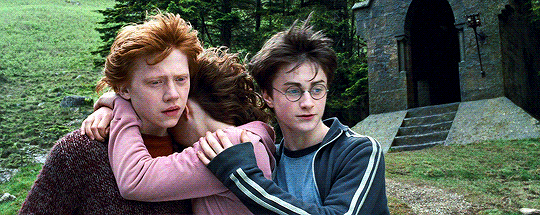
Just love this stupid moment
Well, that's it, I think I've said everything, and from the next part, we can move on to the Marauders themselves :D
#i'm wondering if anyone but me is even interested in this at all#harry potter meta#harry potter#hermione granger#ron weasley#pro ron weasley#rubeus hagrid#pro severus snape#pro albus dumbledore#pro romione#hp meta#severus snape meta#lily evans#tom riddle#voldemort#tom riddle meta#bellatrix lestrange
67 notes
·
View notes
Text

Libra
September 23 - October 23
Thoth, God of Knowledge, and Ma’at
- Goddess of Truth and Divine Justice
The zodiac series: Libra
art by Johfra Bosschart
The tenth holy night of the Christmas season, from January 2 to 3, corresponds to rulerships, the higher intuition (Buddhi, life spirit) and the constellation Libra. In the painting below, Johfra (1919-1998) depicts characteristics of the Libra, and in the following text he provides an explanation.
The Libra is a positive sign, sky in essence, the sign the sun is at the beginning of fall as it crosses the equator to enter the period of winter. The ruling planet is Venus. The distinctive quality of this sign is balance and harmony. That is why the composition of this painting, like that of the Twins, has been kept symmetrical.
In the sign of Libra, the orientation of the soul changes. While in the preceding six signs the emphasis of the evolving human being has been on the self, in the following six signs the non-self is central to the acquisition of experience. It is Venus, the goddess of love, harmony and beauty who reigns here.
It is above all also the balance between head and heart, mind and feeling, which is the aim of this sign. That is why I also involved Thot-Hermes in the performance when compiling the symbolism. Just as I have pictured Mercury as ruler of the mind in his Egyptian form, so here also the goddess Venus appears in her Egyptian form as Hator, the goddess of joy, dance, celebration and love, with cow horns and ears. The two figures keep a balance.
On the one scale the feather of Maat – so again the soul-judgment, but then in connection with love-wisdom. The placement of Mercury to the left and Venus to the right of the balance refers to the kabbalah where Hod, the sefira who rules over the mental aspect in man, stands below on the left pillar of the tree of life (the pillar of austerity), while Nezach, the feeling , is at the bottom of the right pillar (of loving kindness or mercy). So here too the perfect balance between reason and emotion is expressed. Left and right absolutely need each other. Reason without feeling is sterile and deadly. The emotion without the corrective mind is just sentimentality and creates chaos. Both are very dangerous abilities without their polar opposites.
Nezach is the seventh sefira. Hence Hator carries a seven-pointed star between her horns. Below it is the astrological sign of Venus. In her hand she holds a sistrum, the ritual ringing instrument of the Hator priestesses. The four serpentine rods it contains represent the four elements that harmoniously resonate in the cosmos. Winding around the figure of the ibis-headed Thoth are the well-known serpents of the Mercury staff — the negative and positive forces united in harmony. In his hand he holds the ankh cross – the symbol of eternal life among the ancient Egyptians. At the center of his belt is the astrological sign of the planet Mercury.
The harmonic duality of the sign Libra is further depicted in the lower part of the painting by the two Assyrian sphinxes. These represent the chariot (arcanum 7) on the tarot card, which is associated with the sign of Libra. Here the two sphinxes pulling the chariot represent opposing cosmic forces, which work harmoniously under the guidance of the charioteer.
In the painting, the two animals are also symbols of the four elements in a positive (male sphinx) and negative (female sphinx) respect: the head is the element of water, the lion's front legs are the element of fire, the wings are the element of air and the bull's abdomens are the element earth – completely analogous to the four beasts of Ezekiel and the four symbols of the evangelists from the previous sign of Virgo.
The black and white checkered tile floor also refers to the harmonious cooperation of the polar forces at the foundation of the cosmos (this is the floor of the temple of the Freemasons). The lily in the foreground represents the serenity that results from the perfect balance between head and heart.
In the middle of the tiled floor is another Masonic symbol, namely the altar in the shape of a cube. The cube represents the foundation, because it consists of squares. This "cubic stone" is the "cornerstone", the Christ. It is the philosopher's stone of alchemy. This sacred altar in the temple, where the light of the spirit is always burning and never extinguished, was the Hindu symbol for our sign Libra. Officially, this cubic stone should be black and opaque. However, I painted it as a crystal to show the sphere, the golden seed it contains. This also contains the astrological sign for Libra, also in a heptagon, for Venus is related to Nezach (the seventh sefira on the tree of life).
When the cube is unfolded, the six faces form a Christian cross. In that case, the golden seed in the center of this cross. This image is directly reminiscent of the rosary, where the rose is also attached to the center of the cross – see the scales as a rosy cross above. I chose the sign of the Rosycross because this order also strives for the balance between head and heart in building the perfect man. The red rose is the flower of Venus, for it represents self-sacrificing love.
Furthermore, some other symbols related to the union of the opposites: the Chinese yin-yang symbol in connection with the polarization in primordial matter, the superimposed ∞ (the lemniscate, the symbol of infinity), the polar forces of the sun and moon, the spirit and the soul, interacting eternally. - Johfra Bosschart
19 notes
·
View notes
Text
If we're going to keep using the works of historic scientists in this series, Isaac Newton is absolutely perfect for it, especially in association with the Eye.
He literally invented the field of optics in physics, illustrated the color spectrum down to the overlapping wavelengths, finished the debate on color being an intrinsic property of light, created the reflecting telescope, and helped start early debate on the existence of photons. He also helped figure out how the optic nerves work, what rods and cones are, color vision and vision in general.
He was also incredibly reckless and outright stupid sometimes due to lack of care for safety during experiments. He probed the back of his eye with a needle to figure out how to stimulate the optic nerve, deliberately stared directly at the sun and almost blinded himself to figure out after images, and put mercury and shit in his eyes to help figure out tissues. He had a full-on nervous breakdown several different times due to the stress of his studies (and also probably serious mercury exposure).
He didn't care about safety, he cared about knowledge. Very familiar.
He was also the last Western alchemist and cared WAY more about his occult studies than things like helping reinvent physics and calculus. A lot of his occult stuff was unpublished due to expected backlash from other scientists and academics, but he wrote tons of manuscripts on alchemy, finding/creating the Philosopher's Stone, and prophecy regarding the apocalypse.
He was also probably a freemason (though apparently because the society was much more secretive back then there's no actual definitive proof that he was part of anything masonic officially? Either way he definitely hung out with and identified with a lot of freemasons in and outside of academia), which doesn't actually mean anything inherently sinister like it's often portrayed in media (they're basically just a public service/networking org that started out as a stonemason's guild/union and has some religious/philosophical symbolism that they use alongside some occult symbolism - trust me, they can barely organize a charity pancake breakfast let alone take over the world). But still, the Eye symbolism is everywhere in masonic societies in a functional sense via the Eye of Providence/All-Seeing Eye/Eye of Horus. Honestly I'm surprised TMA and TMP haven't used masonic stuff before given how well-known the symbol is and how sensationalized that stuff has become.
Anyway I hope you enjoyed the weird intersection of several of my interests. I like weird science history and TMP so if this comes up again I'm never gonna shut up about it. RIP Isaac Newton you brilliantly weird borderline mad scientist may you live on in this UK horror podcast and also the other stuff you did idk.
#tmp spoilers#tmp#tma#please keep using weird academics in this series i want to verbal vomit about them
19 notes
·
View notes
Text
Good Omens + Masons?
I really think the freemasons will somehow turn up in S3. It's quite clear that the masons are connected to Scotland episodes: masonic symbols in the vault, masonic apron seen on the first body snatched by Elspeth, masonic symbols right on the windows of the Resurectionist Pub and, most importantly, what was said by the pub owner. Mind the red ribbon worn crossbody by Beelzebub, it's actually very much like masonic regalia ribbon. And then there's Maggie's necklace with eye in triangle, and isn't it Maggie, who for some reason is sent all these mysterious records from the Resurectionist.

UPD and also Maggie says "I had brothers!". Freemasons are a fraternal society and address each other as brothers.
26 notes
·
View notes
Note
The fun facts are back! Can I get one please?
I keep thinking of that well-meaning anon from a few weeks back, so I’m going to say Today You Learned about THE MAN WHO RUINED TAROT
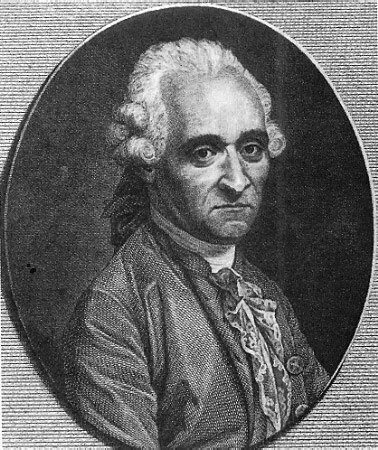
YOU
Antoine Court de Gebelin. But let’s back up.
Tarot is a card game. That is all it was ever meant to be–it was a card game for hundreds of years, and in some places it remains a card game to this day. Then along comes Antoine Court. The man was a Swiss Freemason, formerly a religious pastor, and was apparently well-regarded as a scholar. Due to his support for American Independence, he was given honorary membership to the American Philosophical Society in 1783, when we were a brand spanking new country.
However! He was also interested in the occult, and as the theme for the night apparently is, occultists often ruin things. When he saw tarot cards, something often associated with the Romani people, and saw that they were marked with symbols he didn’t understand, Antoine decided that, naturally, they must be ancient Egyptian symbols, and therefore MAGIC. Because back then they decided everything ancient Egyptian might be MAGIC.
Okay, see, part of the thing is that there was this common perception that the Romani were Egyptian, or descended from them, hence that term for them that they don’t like very much. And remember that people couldn’t read Egyptian hieroglyphics yet–the Rosetta Stone wasn’t discovered and decoded until later, so for all people knew, Egyptian writing could be magic (though that still seems pretty silly to me).
So Antoine came up with a full backstory for these cards, and that they could see the future, and that the symbols were just brimming with occult significance, and now people use tarot cards to tell the future.
For some reason.
Look, it’s nonsense. Tarot cards aren’t a magical tradition carried down from ancient Egypt, that’s a different children’s card game–Duel Monsters. But because this one guy decided “AKSHUALLY, they must be EGYPTIAN!!1!”, and then other occultists ran with it, and packaged it as a trendy way to see the future/make money, what is supposed to be a simple game has warped into this weird occult phenomenon.
Ugh.
81 notes
·
View notes
Text
The Norwood Builder pt 1
Definitely remember the name, but do I remember the story? That is the eternal question. Well, hopefully not eternal. It should be answered soonish.
“London has become a singularly uninteresting city since the death of the late lamented Professor Moriarty.”
Woe, my arch enemy who tried to kill me and very nearly succeeded several times (but who only appeared in one story) is dead. I don't know if this is more indicative of Holmes' character or ACD's lamenting 'look, I raised the stakes so high that time that I'm never going to be able to do that again'. Probably both.
“The community is certainly the gainer, and no one the loser, save the poor out-of-work specialist, whose occupation has gone."
Watson has literally told us twice that 1895 was insanely busy for you. You did a case for the pope. You dealt with that canary guy. Your melodrama is noted, sir.
At the time of which I speak Holmes had been back for some months, and I, at his request, had sold my practice and returned to share the old quarters in Baker Street. A young doctor, named Verner, had purchased my small Kensington practice, and given with astonishingly little demur the highest price that I ventured to ask—an incident which only explained itself some years later when I found that Verner was a distant relation of Holmes's, and that it was my friend who had really found the money.
Holmes really Did That, huh? Wow. Guy has no chill in so many ways. "Come and live with me, Watson, and give up your practice! I'm sure you'll find someone to take it on. What's that? A convenient buyer of whom I know nothing. Nothing at all. Any family resemblance is purely coincidental!"

As it opened there came a tumultuous rush into the hall, rapid feet clattered up the stair, and an instant later a wild-eyed and frantic young man, pale, dishevelled, and palpitating, burst into the room.
What does 'palpitating' mean when referring to a human person?
Ah, so just sort of shaking, then. I've never seen it used like that.
He became conscious that some apology was needed for this unceremonious entry.
I mean, he just entered the dramatic bitch house dramatically, I'm not sure he needs to apologise. You and Holmes do worse once a day and twice on Sundays. Let the boy be dramatic. He's probably earned it. He fits right in, anyway.
"I am the unhappy John Hector McFarlane.”
Once again, I see this and my brain immediately asks if there's a 'happy John Hector McFarlane' out there somewhere, just living his best life, not even palpitating slightly.

“I am sure that with your symptoms my friend Dr. Watson here would prescribe a sedative."
I'm sure he would rather prescribe brandy.
...it was not difficult for me to follow his deductions, and to observe the untidiness of attire, the sheaf of legal papers, the watch-charm, and the breathing which had prompted them.
OK, so Watson's doing really well at working out Holmes' thought processes from his conclusions.

But also, Freemasons really just walking around with their secret society symbol hanging from their watch chain? How is that a secret society?
"I am the most unfortunate man at this moment in London. For Heaven's sake don't abandon me, Mr. Holmes!"
Srsly, my boy is dramatic and he has found his people.
“Arrest you!” said Holmes. “This is really most grati—most interesting.”
Good cover. A+. No one noticed a thing.
“Here it is, and with your permission I will read it to you."
Odd decision to read the article rather than telling your own version of events. But I do love a dramatic reading.
And Watson, you're a bit slow with that brandy. Where is your medical expertise, did you sell it along with your practice to Sherlock's cousin?
"He has had the reputation of being a man of eccentric habits, secretive and retiring. For some years he has practically withdrawn from the business, in which he is said to have amassed considerable wealth."
How very Bilbo Baggins of him. This smells like a motive. I wonder if he has Sackville-Oldacre relatives.
"The police theory is that a most sensational crime has been committed, that the victim was clubbed to death in his own bedroom, his papers rifled, and his dead body dragged across to the wood-stack, which was then ignited so as to hide all traces of the crime."
They're really throwing all the information available out there to the public, huh? No concept of security or secrecy in Victorian London, oh no. We have to put all the dirty details in the paper for everyone to see.
"The conduct of the criminal investigation has been left in the experienced hands of Inspector Lestrade, of Scotland Yard..."
Oh hai, Lestrade!
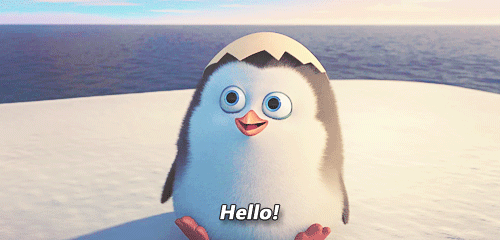
"I knew nothing of this affair until I was in the train, when I read what you have just heard."
Yeah, that'll fuck up your morning and no mistake.
“‘Here is my will,’ said he. ‘I want you, Mr. McFarlane, to cast it into proper legal shape. I will sit here while you do so.’"
No pressure. Just write up this legal document in front of me. Also, it's a will mystery. I love a good will mystery.
"I found that, with some reservations, he had left all his property to me."
Of course he has, I knew he would from the moment you said he knew your parents. Also, this does nothing to make you less of a suspect.
Mr Oldacre is also a member of the dramatic bitch club, it seems. You couldn't just write out your will somewhere else. You had to get the beneficiary to write it out without even telling him he was the beneficiary? No one in this story has the slightest bit of chill.
"The will was duly finished, signed, and witnessed by my clerk."
This feels like a conflict of interest. I feel like the person receiving the inheritance shouldn't be the one to write up the will. I know that Mr Oldacre still had to read and sign it and there was a witness and everything, but it still feels weird.
"‘Remember, my boy, not one word to your parents about the affair until everything is settled. We will keep it as a little surprise for them.’"
I'm guessing that this is because the McFarlane parents have crucial information, such as 'he's a terrible person. we hate him. he will try to frame you for murder' or 'we have never met this man before in our lives'.
We are now getting into the familiar vibe of 'rich person coerces young not-rich person into doing things against their better judgement by promising them money'.
"He remarked that we must not disturb the housekeeper. He showed me out through his own French window, which had been open all this time.”
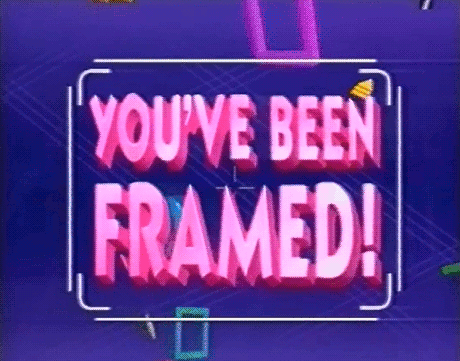
“It strikes me, my good Lestrade, as being just a trifle too obvious,” said Holmes.
I know I say that all the time, but I have the benefit of knowing that I am reading mystery fiction and therefore the most obvious solution is probably not the correct one. Holmes is just being contrary by saying it here. Ninety-nine times out of a hundred the obvious solution is going to be the correct one.
I agree that it would be a stupid move on Mr McFarlane's part, but even so you can't really fault Lestrade for following the evidence to this point.
“Why should the tramp burn the body?”
“For the matter of that why should McFarlane?”
“To hide some evidence.”
The obvious conclusion to draw here is that it's not Mr Oldacre's body. And he has buggered off somewhere quite merrily with the contents of his safe having suitably fucked over Mr McFarlane for as yet unknown reasons. Hope it wasn't a random passing tramp that he beat to death and burnt. Because that's a dick move. If you're going to kill someone, at least have a personal reason for it.
"I dare say that in the course of the day I shall drop in at Norwood and see how you are getting on.”
I assume after your trip to Blackheath? To see what the elder McFarlanes have to say about Mr Oldacre and if they've ever met him. Maybe had him bury someone in a wall or under a patio for them. Normal things.
I don't seem to remember this one, either. Man I really did not pay attention as a child, huh? Makes it more fun this time around, though.
29 notes
·
View notes
Text

Prince of Jerusalem 16°
Morals and Dogma
Part X
We are all naturally seekers of wonders. We travel far to see the majesty of old ruins, the venerable forms of the hoary mountains, great water-falls, and galleries of art. And yet the world-wonder is all around us; the wonder of setting suns, and evening stars, of the magic spring-time, the blossoming of the trees, the strange transformations of the moth; the wonder of the Infinite Divinity and of His boundless revelation. There is no splendor beyond that which sets its morning throne in the golden East; no. dome sublime as that of Heaven; no beauty so fair as that of the verdant, blossoming earth; no place, however invested with the sanctities of old time, like that home which is hushed and folded within the embrace of the humblest wall and roof.
#freemasonry#freemasons#Albert Pike#masonic lodge#illustration#masons#masonic temple#Masonic Education#symbolism#esoteric#art#morals and dogma#occult#hermetic
10 notes
·
View notes
Text
Susan Kay's 'Phantom' Read: Part III (Giovanni)
Now I started out very annoyed that Kay once again chose to hand over the narrative to one of her OC's, proclaiming "this page says 'Giovanni', who the hell is he?"
But actually this section turned out to the the least objectionable episode so far.
Note I say 'least objectionable'.
So for those who haven't read Phantom, Giovanni is one of Kay's composite characters, a master stone mason (and Freemason, which.... dunno how I feel about that) who takes Erik on as an apprentice, slowly building a tentative trust with him, and an almost paternal relationship. Giovanni recognizes Erik true passion for the craft and leaves Erik mostly to his own devices while occasionally providing a steady guiding hand. Giovanni is a foil to the previous dominant male figure in Erik's life, the abusive Javert.
But unfortunately (as I'm given to understand will be a theme in this book) everything goes wonky when a girl enters the picture. The ominously vaunted Luciana, Giovanni's youngest daughter returns from school. She's characterized as spoiled, narcissistic and unstable and develops an immediate infatuation with her father's mysterious and aloof masked apprentice.
I say everything falls apart, not because of the absolutely preventable tragedy that follows, but because that tragedy happens for just... reasons. Giovanni acknowledges that it could have been prevented if he just packed his daughter back off to school as planned but hey-ho.
It all ends with Luciana pestering Erik about his mask until Giovanni finally breaks the tacit bond of trust between Erik and himself by urging Erik to just give in to Luciana's petulant whining. Erik does and Luciana throws herself back into chekhov's terrace balustrade (which Erik had noted shortly prior needed to be replaced) and falls to her death.
While this breach of trust provides a fairly good anecdote for why, even though there have been genuinely compassionate figures in Erik's life, he's still come away with such steadfast trust issues, it is somewhat weakened by the number of times Kay has Giovanni lampshade how this all could have been prevented if he wasn't such a pushover.
And then there's something I noticed in this episode that I've noticed as a growing theme.
Some of you may already have read this in the notes on my previous post on Madeleine's chapters, but I'm starting to think Kay just has serious issues with babies in general.
In Madeleine's narrative we're provided with two extreme ends of a scale regarding the cry of a newborn. The "utterly sexless--piercing, irritating, curiously unattractive" cry of a normal baby, and then Erik's cry which is a "music" that brings tears to her eyes "strangely seduc[es her] body so that [her] breasts ached with a primitive and overwhelming urge to hold him close". This begs the question in my mind: was Erik's cry really so unique, or was this just the phenomenon of a woman not really caring for children until her natural maternal bond with her own baby overrides that, and Kay just has a really twisted way of expressing that?
But then we're introduced to Giovanni and his daughter Luciana.
Giovanni had three daughters before Luciana, and his narrative regarding his daughters is interesting to say the least.
But the moment I parted the covers to look at her I was lost in wonder at the sight that greeted me. She did not look like the wrinkled prune that I had come to believe typified my newborn children. Even then she was beautiful, and her tiny little hand closing around my finger was only a symbol of the tenacity with which she wound herself around my heart in the following years.
Here again we are presented with the ugly image of the normal baby, while the child with attractive, pleasing qualities is characterized as manipulative.
Maybe I'm reading too much into it, but, idk. As one of my commenters said "Freud would have a field day with this woman."
Masterpost
19 notes
·
View notes
Text

THE 7-RUNGED LADDER OF THE MYSTERIES
A symbol of progressive advancement from a lower to a higher sphere, which is common to Freemasonry and to many, if not all, of the Ancient Mysteries. In each, generally, as in Freemasonry, the number of steps was seven.
LADDER, BRAHMANICAL
The symbolic ladder used in the Mysteries of Brahma has seven steps, symbolic of the seven worlds of the Indian universe. The lowest is the Earth; the second, the World of Coexistence; the third, Heaven; the fourth, the Middle World, or intermediate region between the lower and the upper worlds; the fifth, the World of Births, in which souls are born again; the sixth, the Mansion of the Blessed; and the seventh, or topmost round, the Sphere of Truth, the abode of Brahma, who is himself a symbol of the sun.
LADDER, QABALISTIC
The ladder of the Qabalists consists of the ten Sephirot, or Emanations, of Deity. The steps are in an ascending series: Kingdom, Foundation, Splendor, Firmness, Beauty, Justice, Mercy, Intelligence, Wisdom, and the Crown. This ladder forms the exception to the usual number of seven steps or rounds;
LADDER, MITHRAITIC
In the Persian Mysteries of Mithras, there is a ladder of seven rounds, the passage through them being symbolical of the soul's approach to perfection. These rounds are called gates, and in allusion to them, the candidate is made to pass through seven dark and winding caverns, which process is called the ascent of the ladder of perfection. Each of these caverns is representative of a world, or a state of existence, through which the soul must pass in its progress from the first world to the last, the World of Truth. The seven steps are further symbolized by the seven planets and the seven metals. Thus, beginning at the bottom, we have Saturn represented by lead, Venus by copper, Jupiter by tin, Mercury by qiucksilver, Mars by iron, the Moon by silver, and the Sun by gold; the whole being a symbol of the sidereal progress of the sun through the universe.
LADDER OF IZADOSH
This ladder, belonging to the advanced Degrees of Freemasonry, consists of the seven following steps, beginning at the bottom: Justice, Equity, Kindliness, Good Faith, Labor, Patience, and Intelligence or Wisdom. Its supports are love of God and love of our neighbor, and their totality constitute a symbolism of the devoir or duty of Knighthood and Freemasonry, the fulfillment of which is necessary to make a Perfect Knight and Perfect Freemason.
LADDER, ROSICRUCIAN
Among the symbols of the Rosicrucians is a ladder of seven steps standing on a globe of the earth, with an open Bible, Square and Compass resting on top. Between each of the steps is one of the following letters, beginning from the bottom: I. N. R. I. F. S. C., being the initials of Iesus, Nazarenus, Rex, Iudaeorum, Fides, Spes, Caritas. These words suggesting Jesus of Nazareth, King of the Jews, Faith, Hope, Charity. But a more recondite or hidden meaning is sometimes given to the first four letters (INRI - All of Nature is Renewed by Fire).
LADDER, SCANDINAVIAN
Doctor Oliver refers the symbolic ladder used in the Gothic Mysteries to the Yggrasil, or sacred ashtree. It retains the idea of an ascent from a lower to a higher sphere, which was common to all the mystical ladder systems. At its root lies the dragon of death; at its top are the eagle and hawk, the symbols of life.
LADDER, THEOLOGICAL
The symbolic ladder of the Masonic Mysteries refers to the ladder seen by Jacob in his vision, and consists, like all symbolical ladders, of seven rounds, alluding to the four cardinal and the three theological virtues: Temperance, Fortitude, Prudence, Justice, Faith, Hope, and Charity
LADDER, JACOB'S
While sleeping one night on the bare earth and a stone for his pillow, Jacob beheld the vision of a ladder, whose foot rested on the earth and whose top reached to heaven. Angels were continually ascending and descending upon it, and promised him the blessing of a numerous and happy posterity. This ladder, so remarkable in the history of the Jewish people, finds its analogue in all the ancient initiations. It is certain that the ladder as a symbol of moral and intellectual progress existed almost universally in antiquity, presenting itself either as a succession of steps, of gates, of Degrees, or in some other modified form. The number of the steps varied; although the favorite one appears to have been seven, in reference, apparently, to the mystical character almost everywhere given to that number.
-- AN ENCYCLOPEDIA OF FREEMASONRY AND ITS KINDRED SCIENCES by Albert C. Mackey MD
91 notes
·
View notes
Note
I’d really like to talk about malevolent but I’m not always that great at getting my thoughts written down into messages, so here goes:
I really liked your views on the KIY cult-backstory for Arthur, and I was wondering if you thought that Daniel was somehow mixed up in it as well? Because we know that he’s part of the Freemasons in New York and it’s been mentioned that the Order of the Fallen Star may have some members there as well. Since we don’t know the exact role the OotFS play yet in the story, do you think they could be the ones who originally tried to summon/contain the KIY back near the lighthouse (and therefore may tie into your theory)?
DUDE I HAD TYPED OUT ALL THIS SUPER LONG RESPONSE AND MY BROWSER SHUT DOWN AND I LOST IT ALL
time to try and reconstruct :')
so i dont think the order of the fallen star is the same, i initially thought it was kayne's cult. because of course he'd task john to make arthur bring HIM into our world.
regarding daniel and the freemasons, i have another crack theory that they, the freemasons, the order and the kiy cult, if they are all separate, then they are rivaling factions trying to bring their respective god(s) into our reality.
but your suggestion is making me think now, because i've been trying to figure out WHAT the fallen star is? could it be john, the heart, the missing piece of the king, the fallen star from the constellation of the king in yellow? could john have always been somewhat unattached from the king, being something separate that resided in him?
admittedly there have been no references nor symbolism regarding stars in canon (rip my stars john/butterfly arthur agenda hskabdhb) but that would tie nicely into my other other crack theory: arthur and john are the same person in different times. ok hear me out on this one.
malevolent seems to be a story about self-love, ultimately. and arthur, in the show, is said to be the very worst and best humanity has to offer. but harlan, in his asks, seems adamant of arthur's inherent goodness and john's evilness (because he's a ''monster'') but what if arthur at some point makes a sacrifice, because john has been returned to the kiy.
as he was intended too, being groomed by the cult, he tries becoming a vessel of kiy, but somehow instead he become part of him, john's part, the heart. they become one, they become the fallen star. and since eldritch being don't obey the laws of time, john from before he met arthur also has some arthur in him allowing him to become john in the first place and so the madness in arthur is also caused by john.
now this causes weird time shenanigans and i'm not sure if this w.bg effect on me but idk if the show will go in this direction.
anyways sorry, i gave you something completely unrelated from what you asked but hey at least this is a thinly veiled answer-in-a-trench-coat?
#unhinged aromantics#malevolent#malevolent podcast#malevolent fanart#arthur lester#malevolent arthur#arthur malevolent#john doe#john malevolent#malevolent john#malevolent spoilers#red replies#actual cannibal tag
20 notes
·
View notes